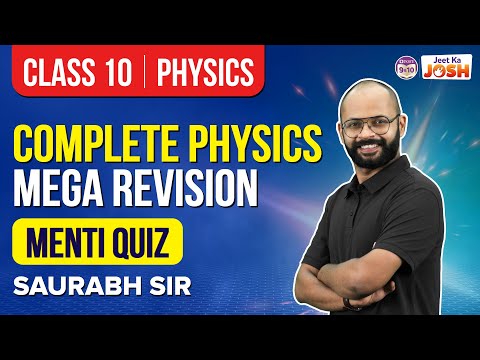Class 10 Physics Chapter 10 Light-Reflection and Refraction MCQs are provided here with answers. These questions are designed as per the latest CBSE syllabus and NCERT curriculum. Solving these chapter-wise MCQs will help students to score good marks in the final exam. Light Reflection and Refraction Class 10 Science MCQs are prepared for a better understanding of the concept. It allows students to test their knowledge and answering skills in the given time frame.
The below video provides the complete CBSE Class 10 Physics Quiz

MCQs on Class 10 Physics Chapter 10 Light-Reflection and Refraction
Check the multiple-choice questions for the Class 10 Physics Chapter 10 Light-Reflection and Refraction. Each MCQ will have four options here, out of which only one is correct. Students have to pick the correct option and check the answer provided here.
Download Chapter 10 Light-Reflection and Refraction MCQs PDF by clicking on the button below.
Download PDF
1. The change in the direction of a wave passing from one medium to another is termed as —————.
- Interference
- Mirage
- Diffraction
- Refraction
Answer: (d) Refraction
Explanation: When the direction of the wave is changed, it is termed as refraction.
2. What would be the angle of incidence for a light ray having zero reflection angle?
- 180 degrees
- 90 degrees
- 0 degree
- 45 degrees
Answer: (c) 0 degree
Explanation: Since we know ∠i = ∠r for reflecting surfaces, therefore if the angle of reflection is zero, then the angle of incidence will also be zero.
3. Light can be focused on our retina through which of the following phenomena?
- Interference
- Refraction
- Diffraction
- Mirage
Answer: (b) Refraction
Explanation: Light rays are focused on the retina after getting refracted through the eye lens.
4. Speed of light in a vacuum is represented as —————.
- a
- v
- c
- l
Answer: (c) c
Explanation: The symbol to represent the speed of light in a vacuum is c.
5. A full length of the image of a distant tall building can be seen using —————.
- a convex mirror
- a plane mirror
- a concave mirror
- none of the options
Answer: (a) a convex mirror
Explanation: A convex mirror always forms a virtual and smaller image irrespective of the position of the object. So, a full-length image of a distant tall building can definitely be seen by using a convex mirror.
6. The ratio of the sine of the angle of incidence to the sine of the angle of refraction is constant. It is given by ……………………
- Faraday’s law
- Snell’s law
- Newton’s law
- Murphy’s law
Answer: (b) Snell’s law
Explanation: According to Snell’s law Sin i/Sin r = constant
7. Twinkling of stars is due to which optical phenomenon?
- Reflection
- Interference
- Refraction
- Divergence
Answer: (c) Refraction
Explanation: A convex mirror always forms a virtual and smaller image irrespective of the position of the object. So, a full-length image of a distant tall building can definitely be seen by using a convex mirror.
8. The laws of reflection are valid for —————.
- a convex mirror
- a plane mirror
- a concave mirror
- all mirrors irrespective of their shape
Answer: (d) all mirrors irrespective of their shape
Explanation: The laws of reflection are valid for all mirrors irrespective of their shapes.
9. Light from the Sun falling on a convex lens will converge at —————.
- Radius of curvature
- Optical centre
- Focus
- None of the options
Answer: (c) Focus
Explanation: Rays from the Sun converge at its focus after refraction through the convex lens.
10. Concave lens produces —————.
- only virtual image
- only erect image
- only diminished image
- virtual, erect, and diminished image
Answer: (d) virtual, erect, and diminished image
Explanation: Concave mirror has the ability to produce a virtual, erect, and diminished image.
Recommended Videos
Watch the video and learn more about the chapter the Human Eye and Colourful World Class 10 |
The below video helps to revise the chapter Light Reflection and Refraction Class 10 |
Stay tuned to BYJU’S and Fall in Love with Learning!
Comments